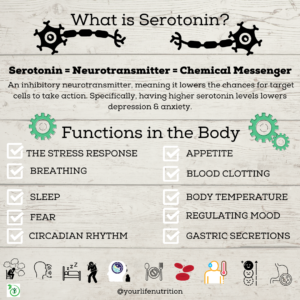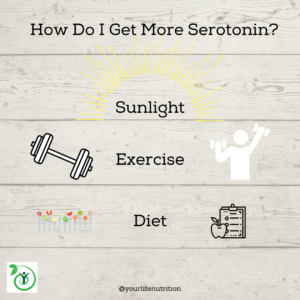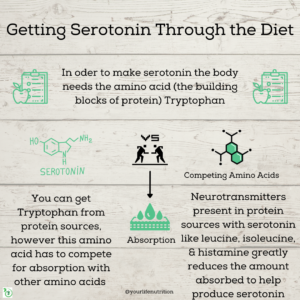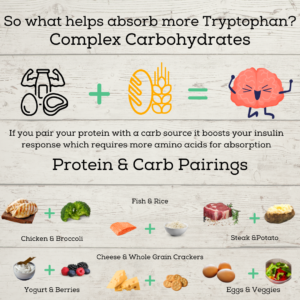Neurotransmitters, or chemical messengers in the body, are well renowned for their role in activating or hushing our “fight or flight” response, but did you know they have another very special role in the body (1)? If you read the last post “Your Gut: The Second Brain” you may remember that there are important hormones and neurotransmitters involved in the gastrointestinal system (your GI tract) that can actually talk to the brain and impact mood, behavior, and cognition (1). We are going to take a closer look at a few of these important neurotransmitters including norepinephrine, epinephrine, dopamine, and serotonin and how they regulate gut motility, nutrient absorption, gastrointestinal innate immune system, and the microbiome (which we discussed more in depth in the previous post). This blog will specifically talk about serotonin, however stay tuned for more on these other important neurotransmitters.
Before we dive into specific gut neurotransmitters, let’s review some basics on the nervous system and its control over our mood and behavior. When you think about what influences mood, behavior, and cognition what comes to mind? You may be thinking of a time where someone’s actions caused you to feel a certain way like the joy you feel when someone gives you a compliment or the frustration when someone ignores you. Perhaps you can think of a time when you stepped on something hard causing you to jolt your foot away from the sensation. These are all examples of outside stimulus causing our thoughts, feelings, and behaviors to react. But why do we do this? Neurotransmitters!
These neurotransmitters are the workforce of the nervous system (2). When you step on something painful, a neurotransmitter takes that signal “pain” and transports it to a target cell (2). In our example, the message “pain” may be sent to your foot muscle cell to tell it to move away from the source of pain (2). Each specific neurotransmitter, for example dopamine, has to go to its unique cell receptor for dopamine (2). But how does a neurotransmitter know where to go and what message to take where? The brain is the head honcho in the body and it is constantly receiving messages and signals and commanding these neurotransmitters to relay a message to a particular target cell (2).
The portion of the nervous system that is involved in the gut is called the enteric nervous system or intrinsic nervous system (1). Even though the GI system has direct contact to the central nervous system (the brain and spinal cord), it is not controlled by it but instead uses this enteric nervous system to control its own independent reflexes (1). This cross-connection between the enteric and central nervous system is known as the “gut-brain” axis (1). Disturbance of this access increases the risk of developing many diseases which is why it is so important to maintain a healthy gut microbiota which influences these important neurotransmitters (1).

The first neurotransmitter we are going to discuss is serotonin. Serotonin is responsible for the gastric secretions and body temperature (1). It also plays a role in regulating mood, appetite, blood clotting, sleep, and the body’s circadian rhythm, breathing, fear, the stress response, and addiction (2-3). This neurotransmitter is an inhibitory neurotransmitter, meaning it lowers the chances for target cells to take action (2). Specifically, having higher serotonin levels lowers depression and anxiety. There is some evidence that points to having higher serotonin levels when exposed to natural or bright lights and having vigorous exercise (2). Low levels of sunlight in the winter often causes seasonal depression since serotonin levels are lower and subsequently affect mood (3). The reason exercise increases serotonin levels is because these activities increase tryptophan, an amino acid needed to synthesize serotonin (3).

Getting Serotonin through the diet is a bit more complex. In order to make serotonin the body needs tryptophan, and amino acid we can get from certain high protein sources (3). However, protein does not necessarily mean tryptophan will be readily available to make serotonin (3). This is because of the blood brain barrier forces different amino acids to compete for absorption, so when we eat a protein source the body will break down all of the amino acids including competing amino acids like leucine, isoleucine, or histamine, so tryptophan may not be as readily absorbed (3). There are many sources containing all of these amino acids, so how do you increase tryptophan’s chances? By pairing protein sources of tryptophan with complex carbohydrate sources (3). This increases tryptophan’s absorption because your body produces insulin in response to carb intake which increases the need for more amino acids (3).
Here is a list of tryptophan containing proteins and complex carbs to pair with them:
Proteins:
- Cheese
- Chicken
- Egg whites
- Fish
- Milk
- Sunflower seeds
- Peanuts
- Pumpkin seeds
- Sesame seeds
- Soy beans
- Turkey
Complex Carbs:
- Whole grains
- Brown Rice
- Oatmeal
- Quinoa
- Starchy Veggies
- Potato
- Sweet Potato
- Corn
- Peas
- Legumes & Beans
- Lentils
- Kidney Beans
- Chickpeas
- Non-Starchy Veggies
- Zucchini
- Asparagus
- Leafy Greens
- Broccoli

Tryptophan’s absorption for serotonin is just one example of why eating balanced meals is so crucial to our health. If all we ate was protein, we wouldn’t have enough tryptophan absorbed to make enough serotonin to keep our digestion moving smoothly or to increase our mood. In a similar manner, if all we ate was carbohydrates, we wouldn’t even have tryptophan available to be absorbed. There are so many great health benefits to pairing food groups together at meals like carbs and proteins. We also see how important exercise is for our health. Not just to increase muscle mass or lose fat, but to keep us happy, better our sleep, digestion, regulate body temperature, and reduce stress, anxiety, and depression. Serotonin is an incredibly beneficial neuro transporter to have on hand, but it is up to us to help provide the best environment for its synthesis and functioning.

Post Created by Student Dietetic Intern of the University of Akron: Michaela Campbell
Works Cited
- Mittal R, Debs LH, Patel AP, et al. Neurotransmitters: The critical modulators regulating gut-brain axis. Journal of cellular physiology.
https://www.ncbi.nlm.nih.gov/pmc/articles/PMC5772764/#:~:text=Neurotransmitters%20including%20serotonin%2C%20norepinephrine%2C%20epinephrine,et%20al.%2C%202009. Published September 2017. Accessed March 29, 2022.
- Neurotransmitters: What they are, functions, and psychology. Medical News Today. https://www.medicalnewstoday.com/articles/326649#summary. Accessed March 29, 2022.
- Watson S. Serotonin: The natural mood booster. Harvard Health. https://www.health.harvard.edu/mind-and-mood/serotonin-the-natural-mood-booster. Published July 20, 2021. Accessed March 29, 2022.






[…] with the microbiome (serotonin) in the previously blogs “Your Gut: The Second Brain” and “The Gut-Brain Axis: Serotonin”. If you have not had a chance to read those yet, be sure to go back to get some basics for the […]